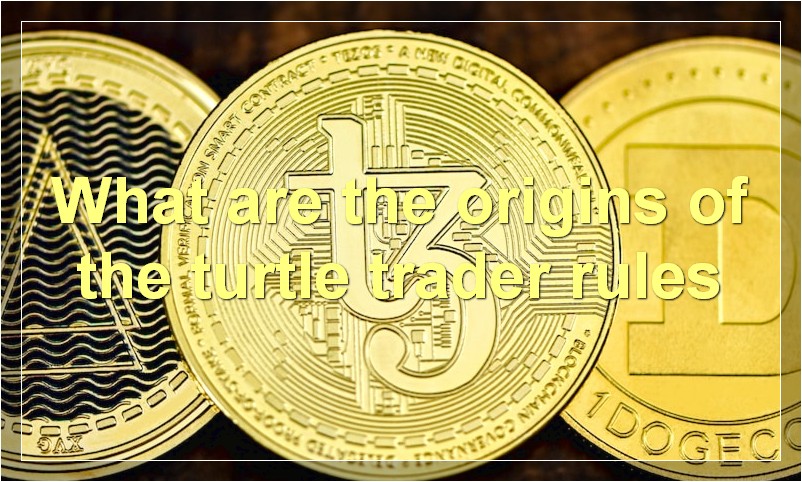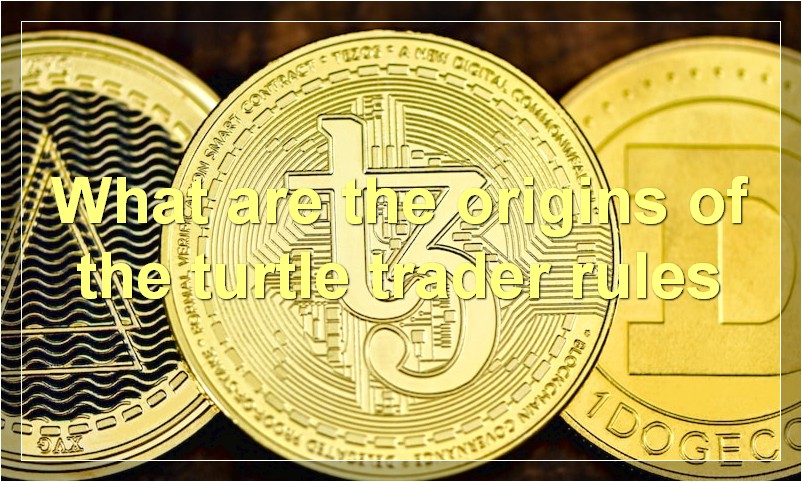If you’re looking for a comprehensive guide to trading like a turtle, then look no further. In this article, we’ll explore the Turtle Trader rules in detail and show you how you can use them to your advantage.
What are the turtle trader rules
In the late 1970s, two Turtle Traders, Richard Dennis and William Eckhardt, recruited and trained a group of individuals with no prior experience in finance using their own money. The experiment was based on the belief that anyone could be taught to trade profitably if they followed a strict set of rules.
The original Turtles were given a set of rules to follow which covered every aspect of their trading strategy from entry to exit. These rules were designed to keep emotions out of the decision-making process and to ensure that each Turtle traded in a disciplined and consistent manner.
The rules are as follows:
1. Enter on breakout of 20-day high/low
2. Use a stop loss of 2 ATRs
3. Only take trades in the direction of the trend
4. Exit when the price hits your profit target or the 10-day low, whichever comes first
5. Always risk 1% of your account on each trade
Since the original experiment, the turtle trader rules have been widely adopted by traders around the world and have become one of the most popular trading strategies. While the original Turtles only traded commodities, the rules can be applied to any market including stocks, forex and futures.
What are the origins of the turtle trader rules

In order to be a successful turtle trader, one must follow a set of specific rules that have been proven to work over time. These rules were originally developed by two experienced traders, Richard Dennis and William Eckhardt, who put them to the test in a now-famous experiment.
The original turtle traders were a group of individuals selected by Dennis and Eckhardt to trade with their own money following the rules they had been given. This experiment was designed to prove that anyone could be taught to trade successfully if they followed a set of simple rules.
The rules themselves are based on technical analysis and are designed to take advantage of market trends. They are relatively easy to follow and can be applied to any market or time frame.
While there is no guarantee of success, following the turtle trader rules can give you a distinct advantage in the markets. By sticking to these tried-and-true rules, you can increase your chances of becoming a successful trader yourself.
How do the turtle trader rules work
The turtle trader rules are a set of guidelines for trading commodity futures. The original turtle traders were a group of traders who were trained by Richard Dennis and William Eckhardt in the early 1980s. The turtle traders used these rules to achieve extraordinary profitability in the futures markets.
The turtle trader rules are based on the premise that markets trend and that it is possible to identify these trends and profit from them. The rules cover every aspect of trading, from money management to entry and exit strategies.
There are two key components to the turtle trader rules: trend following and risk management. Trend following is the strategy of buying or selling in the direction of the prevailing market trend. Risk management is the process of managing your exposure to risk in order to protect your capital and preserve your profits.
The turtle trader rules are a comprehensive trading system that can be used to trade any market. However, they are particularly well suited to trading commodities because commodity markets tend to be more volatile and trend-following strategies can be very profitable in such environments.
What is the philosophy behind the turtle trader rules
The turtle trader rules are based on the philosophy that the markets are fractal in nature, and that price action in the markets reflects the underlying order flow. The turtle traders believe that by following a set of simple rules, they can identify and trade with the trend, and profit from the resulting price movements.
Why do some traders prefer the turtle trader rules
Some traders prefer the turtle trader rules because they are simple and easy to follow. The rules are also designed to keep emotions out of trading decisions, which can help to avoid costly mistakes.
How did the turtle traders become successful

The turtle traders are a group of successful traders who follow a specific set of rules for trading. These rules were originally developed by Richard Dennis and William Eckhardt, two professional traders. The turtle traders used these rules to make profits in the markets, and they became well-known for their success.
The turtle traders’ rules are based on sound principles of risk management and market analysis. They involve setting clear goals, sticking to a strict trading plan, and managing emotions. By following these rules, the turtle traders were able to achieve consistent profits in the markets.
The turtle traders’ story is an inspiring one. They showed that it is possible to make money in the markets if you have a solid trading plan and discipline yourself to follow it. If you are looking to become a successful trader, then you should study the turtle traders’ story and learn from their example.
What lessons can be learned from the turtle trader rules
In the book, The Turtle Trader, author Michael Covel outlines a set of rules that he claims led to a group of novice traders becoming highly successful in the commodities markets. While some may view these rules as nothing more than common sense, others believe that they hold valuable lessons for anyone looking to achieve financial success.
1. One of the most important lessons that can be learned from the turtle trader rules is the importance of risk management. Covel emphasises the need to always protect your downside and never risk more than you can afford to lose. This is a crucial lesson for any investor, whether you are trading stocks, commodities or any other asset.
2. Another important lesson is the need to have a system or method in place before you start trading. The turtle traders followed a set of rules that they had developed through trial and error. These rules allowed them to take emotion out of the equation and made it easier for them to stick to their plan.
3. Finally, the turtle trader rules highlight the importance of discipline when it comes to trading. Even if you have the best system in the world, if you don’t follow it then you are unlikely to be successful. The turtle traders were disciplined in their approach and this helped them to achieve their goal of becoming successful traders.
Are there any drawbacks to following the turtle trader rules
There are a few drawbacks to following the turtle trader rules. First, it can be difficult to find turtles who are willing to stick to the rules. Second, even if you do find turtles, they may not be trading in the same direction as you are, which can lead to losses. Finally, the turtle trader rules can be difficult to follow if you are not experienced in trading.
What other trading strategies are similar to the turtle trader rules
The turtle trader rules are a set of strategies that are used by traders to make money in the markets. There are many different trading strategies out there, but the turtle trader rules are one of the most popular and effective ways to trade.
There are many different ways to trade the markets, but the turtle trader rules are a great place to start. If you want to learn more about other trading strategies, there are plenty of resources out there. The internet is a great place to start your research. There are also many books and courses available on the subject.
Can the turtle trader rules be applied to other markets besides commodities
The turtle trader rules are a set of guidelines for trading commodities that were developed by Richard Dennis and William Eckhardt in the 1970s. These rules can be applied to other markets besides commodities, but they may not be as successful. The reason the turtle trader rules work well with commodities is because commodities are a more efficient market than other markets. This means that there are more buyers and sellers, and the prices reflect this. In other markets, such as stocks, there may be less liquidity and the prices may not reflect the true value of the underlying asset.

